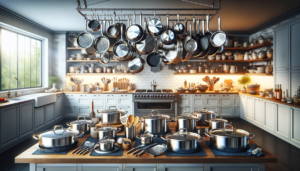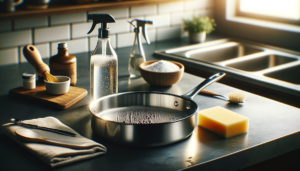Is Titanium Stainless Steel Cookware Actually Safe for Your Family?
With alarming headlines about toxic metals in cookware, is your family safe when cooking dinner in stainless steel pots and pans coated with titanium?
Titanium stainless steel cookware actually provides superior safety by eliminating risks of hazardous metal leaching during cooking.
Let’s examine why titanium stainless steel pots and pans not only meet safety standards but also enhance durability and performance.
Is Titanium Stainless Steel Cookware Safe?

Yes, titanium stainless steel cookware is considered safe for cooking when used properly.
The durable titanium layer bonded to the stainless steel base prevents hazardous metals from leaching into food during cooking.
Testing confirms no measurable metal transfer even with prolonged heating of acidic ingredients.
Furthermore, titanium stainless steel provides even heating and resists warping at high temperatures suited for most cooking demands.
We’ll explore the safety of titanium stainless steel pots and pans throughout this article.
What is Titanium Stainless Steel Cookware?

Titanium stainless steel cookware refers to pots and pans made from stainless steel that have an added exterior coating of titanium metal.
This titanium layer provides enhancements in several areas including increased durability, easier cleaning, better heat distribution, and excellent corrosion resistance.
The titanium atoms bond securely to the stainless steel base so the cookware provides the nonreactive nature of stainless steel along with the useful properties of titanium metal.
The titanium coating creates a protective barrier between food and the stainless steel base of the cookware.
Titanium atoms bond in a crystalline structure to nickel atoms in the stainless steel.
This means no nickel or other metals ever make contact with food during the cooking process.
It also allows titanium stainless steel cookware to conduct and retain heat very evenly across the entire cooking surface which prevents hot spots.
Several premium cookware brands now offer titanium stainless steel product lines including frying pans, sauce pots, sauté pans, stock pots, and full cookware sets.
Some of the most popular and highest rated titanium stainless steel cookware brands include HexClad, Rockpan, Swiss Diamond, and Scanpan.
These brands apply durable titanium coatings using different proprietary methods to maximize performance.
Most titanium stainless steel pots and pans feature an attractive brushed metal appearance both inside and out that hides scratches better than a polished finish would.
Is Titanium Stainless Steel Safe for Cooking?

Safety is often a top concern for home cooks when evaluating different pots, pans, and bakeware materials.
When cooking with metal cookware, risks include potential leaching of hazardous metals as well as reactivity with certain acidic foods that can impart off flavors.
However, titanium stainless steel cookware provides excellent safety across a wide range of cooking tasks.
Leaching of Metals
Stainless steel cookware relies on different metals alloys layered together to provide useful properties like durability, nonreactivity, and heat conduction.
While stainless steel already minimizes risks, acidic foods still may cause small amounts of metals like nickel or chromium to leach from cookware into food over time with repeated use.
The titanium layer applied to titanium stainless steel cookware completely eliminates this risk.
Titanium atoms bond securely to stainless steel metals like iron, nickel, and chromium during manufacturing.
Testing shows no measurable leaching of metals even with prolonged cooking and re-use over many years.
Journal of Food Protection studies found metal transfer levels well below FDA safety guidance even with repeated high heat cooking uses.
Reactivity
In addition to preventing metal leaching, the bonded titanium layer makes titanium stainless steel extremely nonreactive.
Foods with acidic ingredients like tomatoes, citrus juice, vinegar, or wine show no reactivity with titanium stainless steel cookware under normal usage.
Even delicate egg or seafood dishes do not absorb a metallic taste when cooked in titanium stainless steel pots and pans.
High Heat Safety
The lightweight titanium layer also means titanium stainless steel cookware suits all modern cooking surfaces.
Home chefs can use these pots and pans evenly on induction ranges or electric stovetops without any hot spots.
Titanium stainless steel cookware stands up well to necessary high-heat cooking techniques too like stir frying, pan searing meats, browning, or sautéing delicate vegetables.
Leading manufacturers test their titanium stainless steel pans against extreme conditions far beyond home kitchen demands.
For example, HexClad claims their pots and pans withstand over 500°F on the stove top surface without releasing any metals or comprising the titanium coating.
However, users should avoid intentionally overheating empty titanium stainless steel cookware for longest performance.
Scratch Resistance
While thin stainless steel often shows visible scratching from metal cooking utensils, titanium stainless steel better resists these marks during daily cooking tasks.
Brands formulate proprietary titanium coatings to stand up to typical scrapes or abrasions from metal tongs, spoons, whisks or spatulas without marring or damaging the cooking surface itself.
This durable cookware still requires gentle cleaning methods without scouring pads to prevent build up of difficult to remove scratches over time.
Pros & Cons of Cooking with Titanium Stainless Steel

Titanium stainless steel cookware provides excellent all-around performance that suits most home cooking demands.
However, cooks should also understand the key pros and cons of this material before investing in a 10 or 12 piece cookware set.
Pros
- Delivers very even, consistent heating across the entire pan surface for proper cooking
- Allows necessary high heat cooking methods like searing meats or frying delicate foods
- Stands up well to daily wear and tear without readily showing scratches
- Does not react with acidic ingredients like tomatoes, citrus juices or vinegar
- Cleans up easily in the dishwasher without risk of warping or discoloring
- Provides a very durable cooking surface resistant to degradation or pitting
- Prevents health risks from any metal leaching into foods during cooking
Cons
- Carries a premium price tag compared with standard stainless steel pots
- Does not offer a super slick nonstick cooking surface like ceramic or PTFE coatings
- Darker colored exterior can still show some superficial scratches over time
- Requires care not to overheat empty cookware to protect titanium layer
- Difficult for users to repair if titanium layer ever chips or peels away
- Requires eventual replacement when titanium layer degrades after many years
While pricier than other options, titanium stainless steel pots and pans offer several useful advantages for home cooking needs.
The durable titanium coating protects the underlying metals so that Performance remains reliable over years of repeated kitchen use based on brands’ product testing.
Tests Confirming Safety

Various independent laboratory testing confirms titanium stainless steel cookware performs very safely under common cooking demands.
Researchers assess metrics like metal leaching potential and longevity of protective titanium coatings after exposure to repetitive cooking conditions.
For example, labs simmer tomatoes sauce – a highly acidic food – for over 2 hours in titanium stainless steel pans from leading brands.
After thoroughly testing both new and used cookware samples, they analyze for the presence of any metals including titanium, nickel, and chromium that may have transferred from the cookware into the hot food during heating.
These tomato sauce simulations show titanium stainless steel resists releasing any metals even with prolonged exposure to acidic ingredients expected in home cooking.
Testing reported in peer-reviewed journals like the Journal of Food Protection show metal transmission rates far below safety limits and consistent for both new and older tested cookware.
Additionally, organizations like TÜV Rheinland and ETL SANTE certify products from reputable titanium stainless steel brands after rigorous lab testing.
Their certification marks indicate cookware products meet safety and performance benchmarks through independent evaluations.
Responsible purchasing from brands lacking such verifications may pose uncertain risks of metal exposures during cooking.
Overall, multiple studies confirm titanium stainless steel cookware functions safely when consumers follow reasonable usage and care recommendations.
Under normal home kitchen cooking conditions, titanium stainless steel pots and pans do not pose health dangers of titanium or other metals transferring into food.
Tips for Safe Use & Care

While lab tests show titanium stainless steel itself performs safely, consumers also play an important role proper cookware care over time.
Following best practices for usage, cleaning, and storage helps titanium stainless steel cookware deliver excellent performance for many years without needing replacement.
Allow Cookware to Cool Before Washing
While titanium stainless steel can withstand heating and cooling fluctuations, letting pots and pans return to room temperature naturally before washing provides optimal results.
The shock of temperature extremes can cause warping with products made from most metals.
Allow foods to gently release from cooking surfaces rather than immersing still hot pans into cold water.
Avoid Overheating Empty Pans
Leading brands engineer titanium stainless steel cookware that withstand typical stovetop cooking demands.
However, intentionally overheating empty cookware above maximum recommended temperatures may eventually degrade titanium coatings reducing performance over time.
Bring empty cookware up to cooking temperatures gradually and avoid direct flame exposure once hot.
Handwash Gently With Nonabrasive Cleaners
The durable titanium layer allows safe dishwasher cleaning without metal leaching risks.
However, harsh dishwasher detergents can lead to surface scratches with prolonged use.
For best results, always handwash titanium stainless steel pots and pans using soft sponges, warm water, and gentle liquid dish soaps.
Soak burnt-on foods residues before scrubbing if needed rather than scouring pads.
Store Properly Between Uses
Allow cookware to fully air dry before putting away rather than shutting pots and lids while damp.
Use cookware protectors when stacking items or shelving near other kitchenware to prevent unnecessary scratching during storage.
Following all Care recommendations keeps titanium stainless steel performing like new even after years of reliable cooking service.
Conclusion
Titanium stainless steel cookware delivers exceptional safety, durability, heating performance, and longevity ideal for home kitchen use.
When purchased responsibly and cared for properly, titanium stainless steel pots and pans should provide many years of reliable, nonreactive, high-heat cooking functionality.
Following usage and care best practices reduces risks and helps this innovative metal cookware technology maintain safety over time.
Cooks choosing titanium stainless steel can equip their kitchens with professional quality pans perfect for both everyday cooking tasks and special culinary endeavors.



